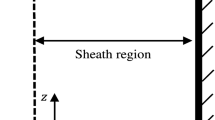Summary
A gas discharge system, as is used for ion sources, is specified by the physical quantities, pressure, applied voltage, geometry and material properties. The potential pattern under any such conditions is ultimately responsible for the ion extraction. The extraction space is the sheath region, occasioned by sharp voltage drops, and the plasma cap is the region held by a potential barrier. The presence and pattern of free charges, under given conditions, account for the plasma sheath disposition that exists over the extraction canal of an ion source (magnetic or nonmagnetic types). By solving a suitably arranged Poisson equation, explicit expressions for the potentials can be found under appropriate conditions. Theoretically, charge injection in this space could profoundly influence this plasma sheath formation for a more favourable potential form and ion outflow; and can set in oscillations of the plasma boundary that would trigger regenerative extraction possibilities.
Riassunto
Un sistema a scarica di gas, del tipo usato per le sorgenti di ioni, è individuato dalle grandezze fisiche, pressione, tensione applicata, geometria e proprietà del materiale. La distribuzione del potenziale in una qualsiasi di tali condizioni è quella che in definitiva determina l’estrazione di ioni. La zona di estrazione è la regione di rivestimento, generata da brusche cadute di potenziale, e la calotta del plasma è la regione mantenuta da un potenziale costante. La presenza e la distribuzione delle cariche libere, in condizioni determinate, spiegano la disposizione dell’insieme plasma-rivestimento che esiste nel canale di estrazione di una sorgente di ioni (sia magnetica che non magnetica). Risolvendo un’equazione di Poisson opportunamente adattata, si possono trovare in opportune condizioni le espressioni esplicite dei potenziali. Da un punto di vista teorico, l’iniezione di cariche in questo spazio potrebbe modificare profondamente la formazione di questo plasma-rivestimento al fine di ottenere una più favorevole distribuzione di potenziale e flusso di ioni; e può generare oscillazioni del contorno del plasma che potrebbero provocare estrazione rigenerativa.
Резюме
Описываются физические парсметры (давление, приложенное напряжение, геометрия и свойства материалов) системы выпуска газа, которая используется как источник ионов. При рассатриваемых условиях конфигурация потенциала является в конечном счете причиной извлечения ионов. Пространство извлечения представляет область внутри оболочки, которая создает резкое падение потенциала, а плазменный колпачок представляет область, которая удерживается потенциальным барьером. Наличие и конфигурация свободных зарядов при определенных условиях объясняют расположение системы «плазма-оболочка», которая существует по всему каналу извлечения для ионного источника (магнитного или немагнитного типов). Решая соответствующее уравнение Пуассона, могут быть получены точные выражения для потенциалов при заданных условиях. Теоретически инжекция заряда в этом пространстве может сильно влиять на образование системы «плазмаоблочка» для наиболее благоприятной формы потенциала и и истечения ионов. При этом могут возникать осцилляции плазменной границы, что может инициировать возможность регенеративного извлечения ионов.
Similar content being viewed by others
References
G. D. Moak, H. Reese, jr. andW. M. Wood:Nucleonics,9, 18 (1951);O. Almen andK. O. Nielsen:Nucl. Instr. Meth.,1, 302 (1957).
J. Kistemaker:Nucl. Instr. Meth.,11, 179 (1961).
J. J. Thomson andG. P. Thomson:Conduction of Electricity through Gases, III Ed., Chap. VIII (Cambridge, 1933);I. Langmuir andK. T. Compton:Rev. Mod. Phys.,3, 191 (1931);A. Von Engel:Ionised Gases, Chap. VIII (Oxford, 1955).
J. B. Hasted:Physics of Atomic Collisions, Chap. III, Sect.16 (London, 1964).
S. C. Brown:Basic Data of Plasma Physics (Cambridge, Mass., and New York, N. Y., 1959), p. 275;I. Langmuir:Collected Works, edited byC. Guy Suite, Vol.4 (London, 1961), p. 326.
N. K. Majumdar:Proceedings of the Symposium on Ion Sources and Formation of Ion Beams (Brookhaven National Laboratory, 1971), p. 35.
N. K. Majumdar:Nucl. Instr. Meth.,88, 205 (1970).
A. Von Engel:Delft Symposium on Electrical Discharges in Gases (1955), p. 34.
P. Thoneman, J. Moffatt, O. Roaf andJ. Sanders:Proc. Phys. Soc.,61, 483 (1948).
N. K. Majumdar:Proceedings of the Nuclear Physics and Solid State Physics Symposium (Roorkee, 1969), p. 296.
S. K. Mukherjee, N. K. Majumdar andA. K. Ganguly:Ind. Journ. Phys.,34, 307 (1960).
Author information
Authors and Affiliations
Additional information
To speed up publication, the author of this paper has agreed to not receive the proofs for correction.
Traduzione a cμra della Redazione.
Перебедено редакицей.
Rights and permissions
About this article
Cite this article
Majumdar, N.K. A plea for charge injection for ion extraction. Nuovo Cim B 29, 178–188 (1975). https://doi.org/10.1007/BF02732238
Received:
Published:
Issue Date:
DOI: https://doi.org/10.1007/BF02732238




